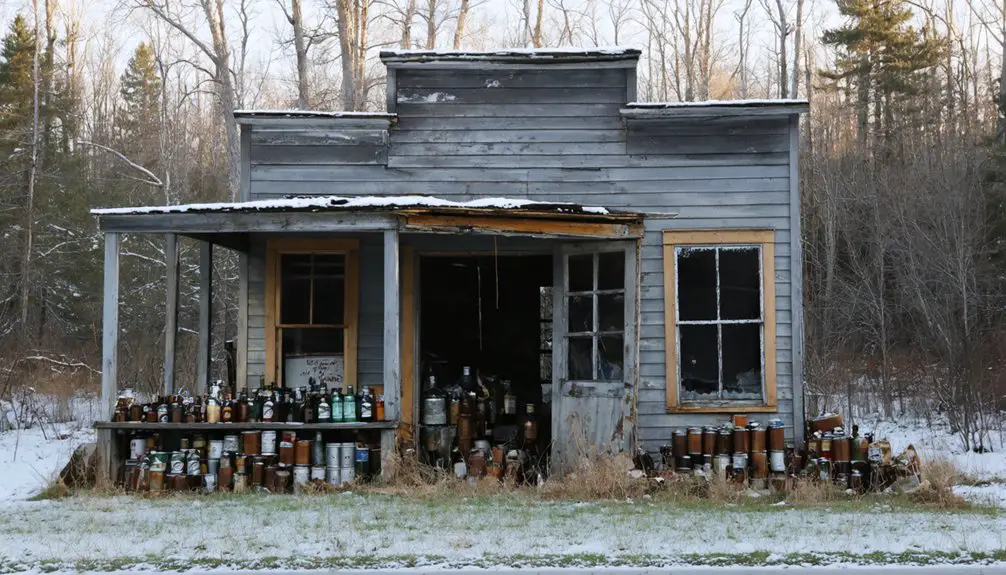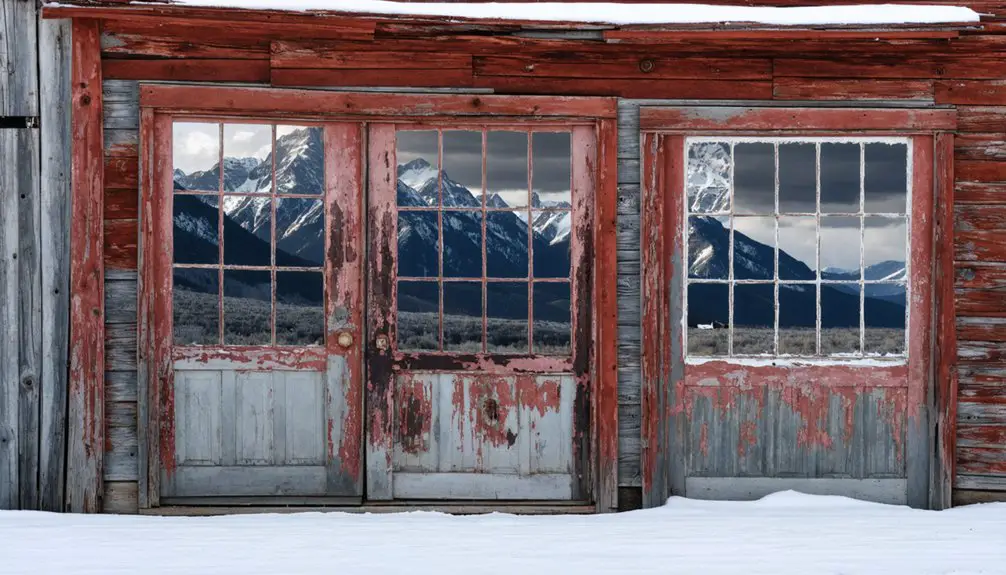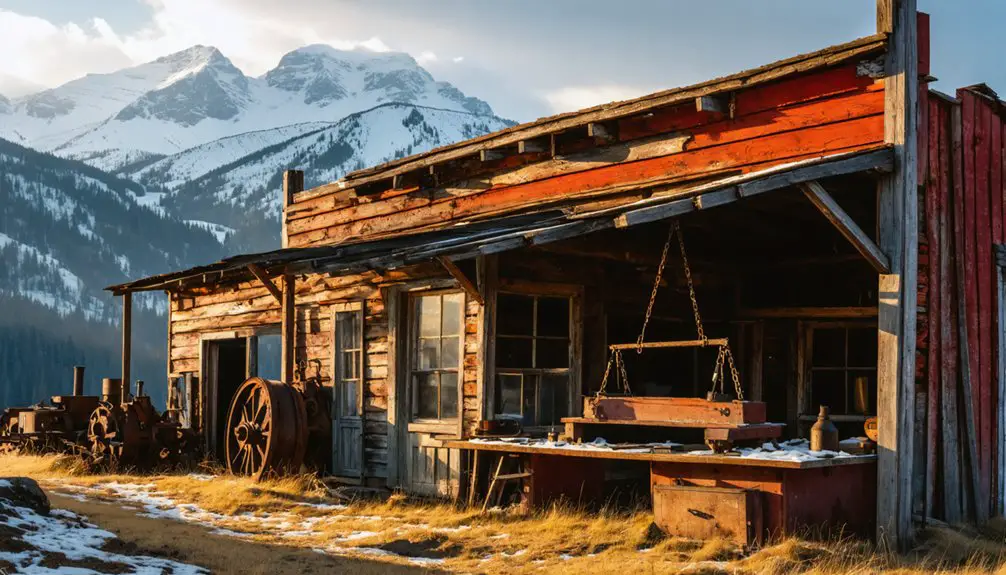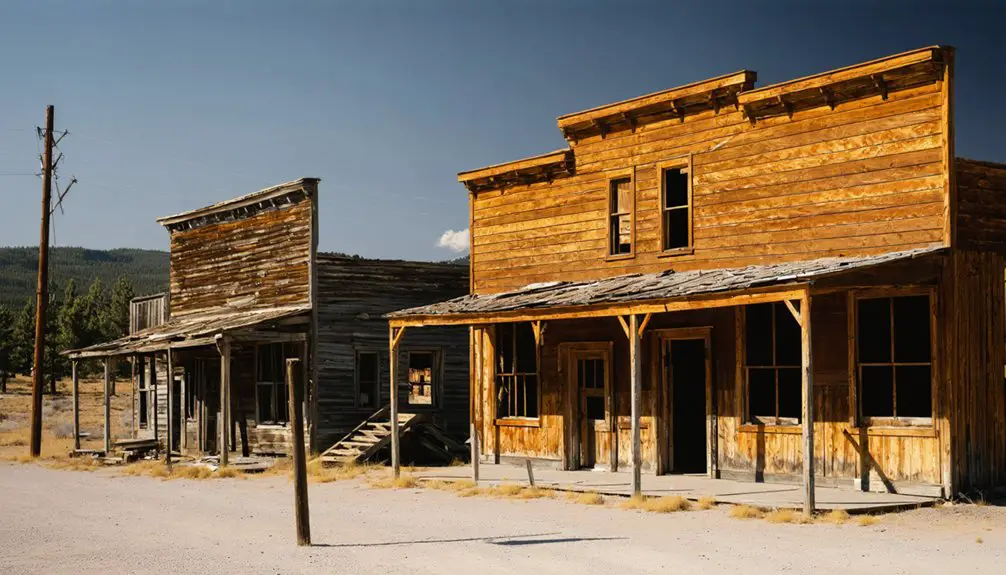You’ll discover the remnants of a once-thriving gold rush town in Oregon’s Blue Mountains, where A.G. Tabor first struck gold on July 4, 1862. Originally named Independence, Granite grew to 5,000 residents by 1900, boasting six hotels, 25 stores, and two newspapers. The town’s fortunes changed dramatically when gold mining became illegal during WWII in 1942. Today, abandoned buildings and mining sites tell fascinating tales of prosperity, diversity, and ultimate decline in this historic ghost town.
Key Takeaways
- Granite, Oregon was a thriving gold mining town established in 1862 that reached a peak population of 5,000 residents by 1900.
- The town featured six hotels, 25 stores, and two newspapers during its heyday, with most residents working in the twelve productive mines.
- World War II caused Granite’s decline when gold mining became illegal in 1942, forcing residents to seek employment elsewhere.
- By the 1960s, Granite became a ghost town with only two residents remaining, after losing essential services like electricity and telephone.
- Today, visitors can explore historic buildings, including the original schoolhouse, general store, and mining infrastructure along Onion Creek.
The Gold Rush That Started It All
When gold was discovered along Granite Creek on July 4, 1862, it sparked a defining chapter in Oregon’s mining history. Following California’s 1848 Sutter’s Mill discovery, prospectors ventured north, establishing the original mining camp of Independence just 1.5 miles from modern-day Granite. A.G. Tabor staked the first claim and became the settlement’s first postmaster, marking the beginning of organized community services.
You’ll find that early mining efforts focused on placer mining, with pioneers using pans and sluice boxes to extract gold from stream gravel. The area eventually grew to include twelve producing mines that helped establish the region as a significant gold producer. The town was officially renamed to Granite in 1874 due to conflicts with mail delivery to other towns named Independence.
As surface deposits depleted, miners shifted to more challenging hard rock mining operations underground. This technological evolution transformed the region’s mining landscape and set the stage for northeastern Oregon’s rapid expansion throughout the 1860s.
Rise to Mining Town Glory
After the initial gold discovery in 1862, Granite quickly transformed from a simple mining camp into a bustling town with over 5,000 residents by 1900.
You’d have found a thriving business district featuring six hotels, 25 well-stocked stores, two newspapers, and multiple saloons serving the growing population.
The town’s impressive infrastructure included a gravity-fed water system for fire protection, while the Grand Hotel‘s 42 rooms welcomed miners and travelers seeking their fortunes in this promising frontier settlement.
The town was initially called Independence, but was renamed to avoid confusion with another settlement of the same name.
The area’s rich deposits of gold were found in the town’s extensive granite bedrock, which was formed millions of years ago from cooling magma deep beneath the Earth’s surface.
Gold Discovery Sparks Growth
The discovery of gold along Granite Creek on July 4, 1862, transformed a remote Oregon wilderness into a bustling mining settlement originally known as Independence.
You’ll find that A.G. Tabor staked the first mining claim and established himself as the area’s only merchant, later becoming the first postmaster in 1878 – the same year the town’s name changed to Granite due to conflicts with another Oregon settlement.
Gold mining sparked an economic boom that drew thousands of fortune seekers. Over eighty percent of workers depended on the mining industry for their livelihood. Chinese immigrants contributed significantly to the area’s mining operations, leaving behind their legacy in the impressive Chinese Walls that still stand today.
By the turn of the century, you’d have seen a thriving community of up to 5,000 people, complete with two hotels, five saloons, a drug store, and various merchants.
Store inventories reached values between $15,000 and $25,000, showing just how much wealth flowed through this remote mountain town.
Booming Business and Infrastructure
During Granite’s meteoric rise, substantial investments in infrastructure transformed the remote mining settlement into a sophisticated boomtown.
You’d have found twelve productive mines surrounding the town, including the renowned Red Boy and May Queen operations, employing over 80% of the local workforce.
The town’s infrastructure investment included a $20,000 sawmill, electric power plant, and cold storage facility. Baker and Grant counties jointly funded $6,000 in road improvements connecting Granite to Sumpter.
Community growth flourished with the addition of two churches, a public school, and diverse commercial establishments including five saloons, two hotels, and multiple drugstores.
The California Power Company’s $2,500 electrical installation and the development of telegraph and telephone lines further modernized the town, while abundant timber resources at $6.00 per thousand board feet supported ongoing construction needs.
Peak Population Reaches Thousands
While infrastructure development laid the groundwork for Granite’s success, a remarkable surge of fortune-seekers transformed this remote Oregon settlement into a bustling metropolis of 5,000 residents by 1900.
The population dynamics revealed fascinating social tensions as Chinese immigrants made up 60% of the town’s residents, working alongside American miners in what became a complex cultural tapestry. The Chinese workers showed remarkable skill by extracting gold from tailings that other miners had discarded as worthless.
You’d have witnessed:
- A swift population explosion following Jack Long’s gold discovery in July 1862
- The establishment of a mainly male workforce driven by mining prospects
- A diverse community supporting five saloons, two newspapers, and multiple businesses
This demographic surge wasn’t destined to last forever – by the 1960s, you’d find just two stubborn souls remaining in what would become one of Oregon’s most famous ghost towns. The town’s dramatic decline began when gold mining became illegal during World War II in December 1942.
Daily Life in Boom Times
At its peak in the late 1800s, Granite bustled with nearly 5,000 residents who enjoyed a surprisingly sophisticated small-town life.
Despite its remote location, Granite thrived as a bustling gold rush town, offering its 5,000 residents an unexpectedly refined frontier experience.
You’d find six hotels and restaurants dotting the streets, including an impressive 65-room establishment. While mining families faced harsh winters and uncertain fortunes, the town offered numerous recreational activities to lift spirits.
You could catch up on local news at either The Boulder or The Gem newspapers, spend evenings at one of five saloons, or handle daily errands at various merchant shops. Like nearby Cornucopia mining hub, Granite attracted thousands seeking their fortune in precious metals.
The town’s infrastructure included electricity, telephone service, and a gravity-fed water system. Whether you needed a blacksmith to repair mining equipment or a drugstore for medical supplies, Granite’s merchants kept the community functioning despite the challenging boom-and-bust nature of gold rush life.
From Prosperity to Abandonment

This vibrant frontier life wouldn’t last forever. You can trace Granite’s economic transformation through the stark shifts of the early 20th century, as declining gold yields signaled the beginning of the end for this once-thriving town.
The most devastating blow to Granite’s cultural heritage came with the 1942 War Labor Act, which banned gold mining and scattered the remaining population to shipyards and military service.
By 1960, what was once a bustling town of 2 permanent residents remained.
Key factors that accelerated Granite’s decline:
- The complete halt of mining operations during WWII
- Mass exodus of residents seeking wartime employment elsewhere
- Subsequent cutoff of essential services like electricity and telephone
Modern-Day Adventures and Exploration
Despite its decline from a bustling gold rush town, modern-day Granite beckons adventurers with a unique blend of historical exploration and outdoor recreation.
You’ll find an extensive network of trails, including the North Fork of the John Day River Trail and Blue Mountain Trail, perfect for hiking and wildlife viewing. The surrounding mountainous terrain offers camping, fishing, and photography opportunities at spots like Olive Lake and Fremont Powerhouse.
While exploring the town’s historic buildings, you can join guided historical tours or venture independently through the preserved schoolhouse, church, and dance hall.
The Granite Cemetery provides a poignant glimpse into pioneer life, while The Lodge at Granite serves as your base for extended adventures.
Don’t miss William Sullivan’s “100 Hikes” guide to maximize your exploration of this remarkable ghost town.
Notable Buildings and Historical Sites

When you visit Granite today, you’ll find several well-preserved structures from its mining heyday, including the historic Cougar-Independence mine complex and the original 19th-century schoolhouse.
The town’s commercial district features the surviving general store and remnants of what were once numerous hotels and saloons that served the bustling population during the 1900s gold rush era.
Along W Center Street, you can spot the Granite Town Hall, which stands as a monument to the town’s peak period when it served as the administrative center for this thriving mining community.
Mining Buildings Still Standing
Several mining structures from Granite’s gold rush era remain scattered across the landscape, offering visitors tangible connections to the town’s prosperous past. The mining architecture includes well-preserved buildings near Cabell City, historic mills, and underground shafts like the Cougar-Independence mine.
Despite preservation efforts, many sites remain restricted due to safety concerns.
- The Granite Outback general store still functions as a local landmark
- Mining infrastructure along Onion Creek showcases remnants of sluice boxes and mill foundations
- Dense alder growth surrounds intact mining buildings eight miles north at Cabell City
You’ll find evidence of mining evolution throughout the area, from simple wooden frames to mechanized equipment sites.
Dredge ponds, spoil piles, and machinery foundations mark the shift from placer to hard rock mining operations.
Historic Hotels and Saloons
Granite’s social life revolved around its impressive hotels and saloons during the town’s golden age from 1862 to 1942. The Grand Hotel stood as the town’s premier historic accommodation, offering 42 rooms and meals to weary travelers and miners until the late 1930s.
A second hotel helped serve the bustling population of 5,000 residents at its peak around 1900.
You’d have found five bustling saloons where miners gathered for social gatherings and celebrations. These establishments came alive when successful prospectors struck gold, with tales of miners tossing gold dust across bars to pay for drinks.
The Grand Hotel’s destruction in 1943 marked the end of an era, but during Granite’s heyday, these venues created a vibrant social scene that defined the town’s character.
Original Post Office Location
The establishment of a post office in 1878 marked a pivotal turning point for the town’s identity, as the settlement officially changed its name from Independence to Granite due to naming conflicts with another Oregon town.
You’ll find this historic post office site about 1.5 miles east-southeast of the original mining camp, where A.G. Tabor, the town’s first postmaster and prominent local businessman, managed mail operations until 1957.
Key features of Granite’s post office history:
- Served as the community’s central communication hub during the late 1800s mining boom
- Located strategically near main transportation routes and mining infrastructure
- Helped transform the settlement from a mining camp into an incorporated city by 1900
The post office’s legacy lives on through historical markers and records, though the building no longer stands in this remote ghost town.
Preserving the Mining Legacy

Since the discovery of gold on July 4, 1862, preserving Granite’s rich mining heritage has become essential to understanding Oregon’s mineral rush era.
You’ll find numerous original buildings still standing, including hotels and saloons that once served a bustling population of 5,000 residents by 1900. The community’s heritage preservation efforts showcase the shift from placer to hard rock mining, with sites like the Cougar-Independence mine remaining accessible to visitors.
Today’s small but dedicated population of about 24 residents continues this legacy through community engagement, maintaining historical landmarks and organizing educational tours.
While they face challenges like limited funding and seasonal accessibility, local historical societies work tirelessly to protect these irreplaceable remnants of Oregon’s mining past through digital archives and guided experiences.
Frequently Asked Questions
What Was the Average Annual Gold Production During Granite’s Peak Mining Years?
You’ll find that gold extraction reached 2,000-6,000 ounces annually during 1880-1914, when diverse mining techniques combining placer and lode operations drove peak production in this rich mineral district.
Were There Any Notable Conflicts Between Native Americans and Early Settlers?
Like a powder keg ready to explode, you’ll find cultural clashes erupted during the Rogue River Wars (1855-1856), with territorial disputes leading to violent confrontations between Native Americans and settlers throughout Southern Oregon’s mining regions.
How Did Children Receive Education in Granite During the Mining Boom?
You’d find children receiving basic education methods through the town’s public school, which provided fundamental skills like reading and arithmetic while adapting to the mining community’s transient nature and economic ups-and-downs.
What Happened to the Town’s Cemetery, and Where Were Residents Buried?
You’ll find the original cemetery still stands in partial decay behind old buildings. No grave relocation occurred – residents were buried there during the boom, with distinct sections for infants and unmarked graves.
Did Any Famous Outlaws or Historical Figures Ever Visit Granite?
Despite having 5,000 residents at its peak, you won’t find any documented outlaw legends or famous historical visitors in Granite’s story. The town attracted miners and merchants rather than notorious characters.
References
- https://www.islands.com/1931526/hidden-oregon-smallest-city-abandoned-mining-town-outdoor-activities/
- https://westernmininghistory.com/towns/oregon/granite/
- https://www.youtube.com/watch?v=vcUSHNMGLDU
- https://www.historicsumpter.com/granite-oregon-ghost-town/
- https://www.madraspioneer.com/townnews/geology/tales-of-the-past-from-mining-boom-town-to-ghost-town/article_86efeef4-42db-11ef-9e21-0f0866317c7c.html
- https://www.oregonhistoryproject.org/narratives/the-world-rushed-in-northeastern-oregon/bonanza-times-and-after/law-order-and-diversity/
- https://traveloregon.com/things-to-do/culture-history/ghost-towns/granite/
- https://en.wikipedia.org/wiki/Granite
- https://www.gcoregonlive.com/cities/granite/
- https://we3travel.com/granite-oregon-gold-rush-history-outdoor-adventure/



